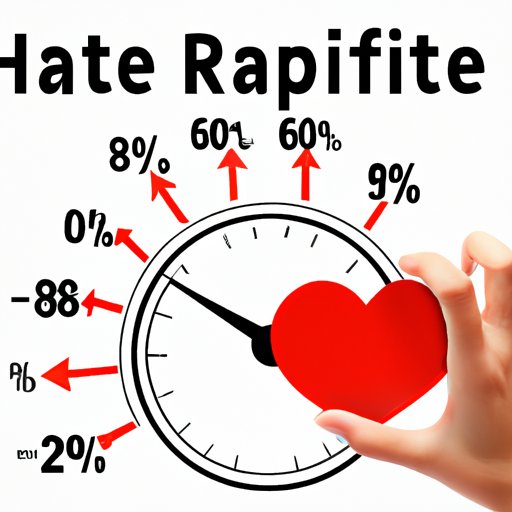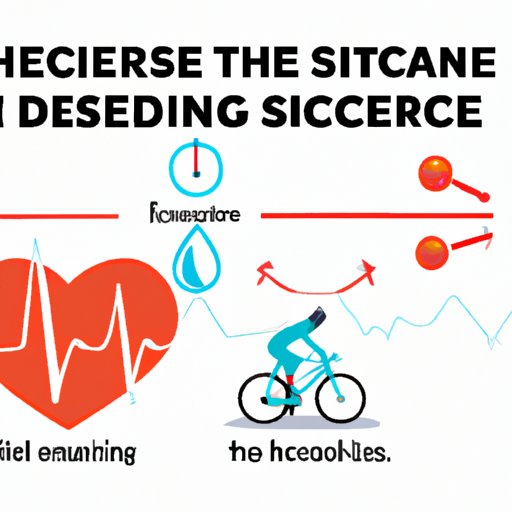
Introduction
Have you ever wondered why your heart rate increases when you exercise? It’s a question many people ask, and for good reason – understanding why your heart beats faster during physical activity is key to understanding how your body responds to exercise. In this article, we will explore the science behind increased heart rate during exercise, the importance of a higher heart rate during workouts, the relationship between heart rate and exercise intensity, how your body adapts to physical activity, how to monitor your heart rate during exercise, the benefits of increased heart rate during exercise, and common myths about heart rate increase during exercise. By the end of this article, you’ll have a deeper understanding of why your heart rate increases during exercise and how you can use this knowledge to improve your overall fitness.

The Science Behind Increased Heart Rate During Exercise: Explained
The heart is a muscle responsible for pumping blood throughout the body. When you exercise, your muscles require more oxygen and nutrients, and your heart must work harder to meet this demand. This increased workload causes the heart rate to increase. Heart rate is the number of times your heart beats per minute, and it can vary depending on a number of factors, including physical activity, stress, and overall health.
During exercise, the body’s demand for oxygen and nutrients increases, which causes the heart to pump faster and harder to supply the necessary nutrients to the working muscles. As a result, the heart rate increases to ensure that enough oxygen and nutrients are delivered to the body’s cells. The increase in heart rate also helps to remove waste products such as carbon dioxide and lactic acid from the muscles.
The Importance of a Higher Heart Rate During Workouts: What You Need to Know
A higher heart rate during exercise is important for improving physical fitness. When the heart rate increases during exercise, it forces the heart to work harder and become stronger. Over time, this leads to improved cardiovascular fitness, as the heart becomes more efficient at pumping blood throughout the body. This increased efficiency also means that the heart doesn’t have to work as hard to supply the body with oxygen and nutrients, which can help reduce the risk of heart disease and other health problems.
A higher heart rate during exercise is also important for building endurance. When you exercise, your body adapts to the increased workload by producing more mitochondria, the energy-producing organelles found within cells. This increased number of mitochondria allows the body to produce more energy during exercise, which can lead to improved endurance. Additionally, a higher heart rate can also help to increase the body’s overall oxygen uptake, which can also improve endurance.
The Relationship Between Heart Rate and Exercise Intensity: Factors to Consider
The relationship between heart rate and exercise intensity is an important one to understand. As exercise intensity increases, so does heart rate. This is because the body requires more oxygen and nutrients as the intensity of the exercise increases, and the heart needs to work harder to supply these nutrients to the body’s cells.
There are several factors that can affect heart rate during exercise, including age, gender, genetics, overall health, and fitness level. Exercise intensity, duration, and type can also affect heart rate. For example, high-intensity interval training (HIIT) can cause a greater increase in heart rate compared to steady-state cardio due to the short, intense bursts of activity.
To determine the appropriate exercise intensity based on heart rate, it’s important to first establish your maximum heart rate. This can be done by subtracting your age from 220. For example, if you’re 30 years old, your maximum heart rate would be 190 bpm (220 – 30 = 190). From there, you can determine your target heart rate, which is typically 60-85% of your maximum heart rate, depending on your fitness level and goals.
How Your Body Adapts to Physical Activity: Understanding Increased Heart Rate
When you first start exercising, your body may respond with a rapid increase in heart rate. This is because your body is not yet accustomed to the increased demand for oxygen and nutrients. However, over time, your body will adapt to the increased workload and become more efficient at delivering oxygen and nutrients to the body’s cells.
Regular exercise can lead to a number of long-term health benefits, including improved cardiovascular health, increased strength and muscle mass, and reduced risk of chronic diseases such as diabetes and heart disease. These benefits are the result of the body’s adaptation to physical activity, which includes an increase in heart rate and other physiological changes.
Tips for Monitoring Your Heart Rate During Exercise to Maximize Your Workout
Monitoring your heart rate during exercise is an important way to ensure that you’re getting the most out of your workout. There are several ways to measure heart rate, including using a heart rate monitor, checking your pulse manually, or using a fitness tracker.
To use heart rate to maximize your workout, it’s important to know your target heart rate based on your fitness level and goals. This can help you determine the appropriate exercise intensity for your workouts. Additionally, tracking your heart rate during exercise can help you identify trends in your fitness level over time.
The Benefits of Increased Heart Rate During Exercise: What Happens to Your Body
There are many benefits to increased heart rate during exercise. Short-term benefits include an increase in blood flow and oxygen delivery to the body’s cells, improved mood and mental clarity, and a boost in energy levels. Long-term benefits include improved cardiovascular health, increased endurance and strength, and a reduced risk of chronic diseases.
When the heart rate increases during exercise, the body’s cells receive more oxygen and nutrients, which can help to improve overall health and wellbeing. Additionally, the increase in heart rate can also help to flush out harmful toxins and waste products from the body, further improving overall health.
Debunking Common Myths About Heart Rate Increase During Exercise
There are many myths about heart rate increase during exercise, including the idea that if you have a high resting heart rate, you should avoid exercise. This is not true – in fact, regular exercise can help to improve cardiovascular health and lower resting heart rate over time.
Another common myth is that heart rate monitors are not accurate. While there can be variations in heart rate measurements depending on the type of monitor and method of measurement used, heart rate monitors are generally considered to be a reliable way to monitor heart rate during exercise.
Conclusion
In conclusion, understanding why your heart rate increases during exercise is key to understanding how your body responds to physical activity. By increasing your heart rate during exercise, you can improve your cardiovascular health, increase endurance, and reduce the risk of chronic diseases. With the tips and information provided in this article, you can start monitoring your heart rate during exercise to maximize your workouts and improve your overall fitness.




